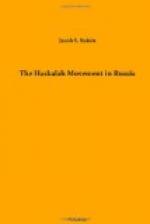To the credit of the Jewish financiers be it said that they were always the banner bearers of enlightenment. It had been so with German Aufklaerung, when Ben-David, Itzig, Friedlaender, and Jacobson, laid the corner-stone of the intellectual rebirth of their people. It was more especially so in Russia during the “sixties.” Odessa was the most enlightened, because it was the wealthiest, of Jewish communities, as the benumbing poverty of the Pale was largely to blame for the unfriendly attitude towards whatever did not bear the stamp of Jewishness on its surface. The Society for the Promotion of Haskalah, too, owes its existence to some of the most prominent Russo-Jewish merchants. Its original officers were Joseph Yosel Guenzburg, President; his son Horace Guenzburg, First Vice-president; Rabbi A. Neuman, Second Vice-president; the Brodskys, and, the most active of them all, its Secretary, Leon Rosenthal (1817-1887). Busy as he was with his financial affairs, Rosenthal devoted considerable time to the propagation of enlightenment among his coreligionists. Many a youthful Maskil was indebted to him for material as well as moral support, and it was due to him that Osip Rabinovich finally succeeded in publishing the Razsvyet (Dawn, 1860), the first journal in Russian devoted to Jewish interests.
The Society for the Promotion of Enlightenment was not unlike the Alliance Israelite Universelle, only on a smaller scale. Its object was “to spread the knowledge of the Russian language among the Jews, to publish and assist others in publishing, in Russian as well as in Hebrew, useful works and journals, to aid in carrying out the purposes of the Society, and, further, to assist the young in devoting themselves to the pursuit of science and knowledge.” For several years, owing to the indifference of the public, it had a hard struggle to live up to its ideal. But continuously, if slowly, it gained in membership, so that in 1884 it had an affiliation of 545. During the first twenty years of its existence its income amounted to 338,685 rubles, its expenditures to 309,998 rubles. In 1880 it endowed an agricultural college for Jewish boys. When, in the same year, medical schools for women were opened, and Jewish girls in large numbers took up the study of medicine, the Society set aside the sum of 18,900 rubles for the support of the needy among them. Many a young man was aided in the pursuit of his chosen career by the Society. It directed its activities principally to the younger generation, yet it did not neglect the older. With its assistance Sabbath Schools and Evening Schools were opened in Berdichev, Zhitomir, Poltava, and other cities; libraries were founded; interesting Hebrew books on scientific subjects were published. Thus it had a two-fold object: in those who were drifting away it aimed to reawaken knowledge or love of Judaism by translating some of the most important Jewish books into Russian (the Haggadah, in 1871, the prayer book, Pentateuch, and Psalms, in 1872) as well as text-books and catechisms; and it popularized science among those who would not or could not read on such topics in Russian or other living tongues. In both directions it was a power for good among the Jews of Russia.[10]




